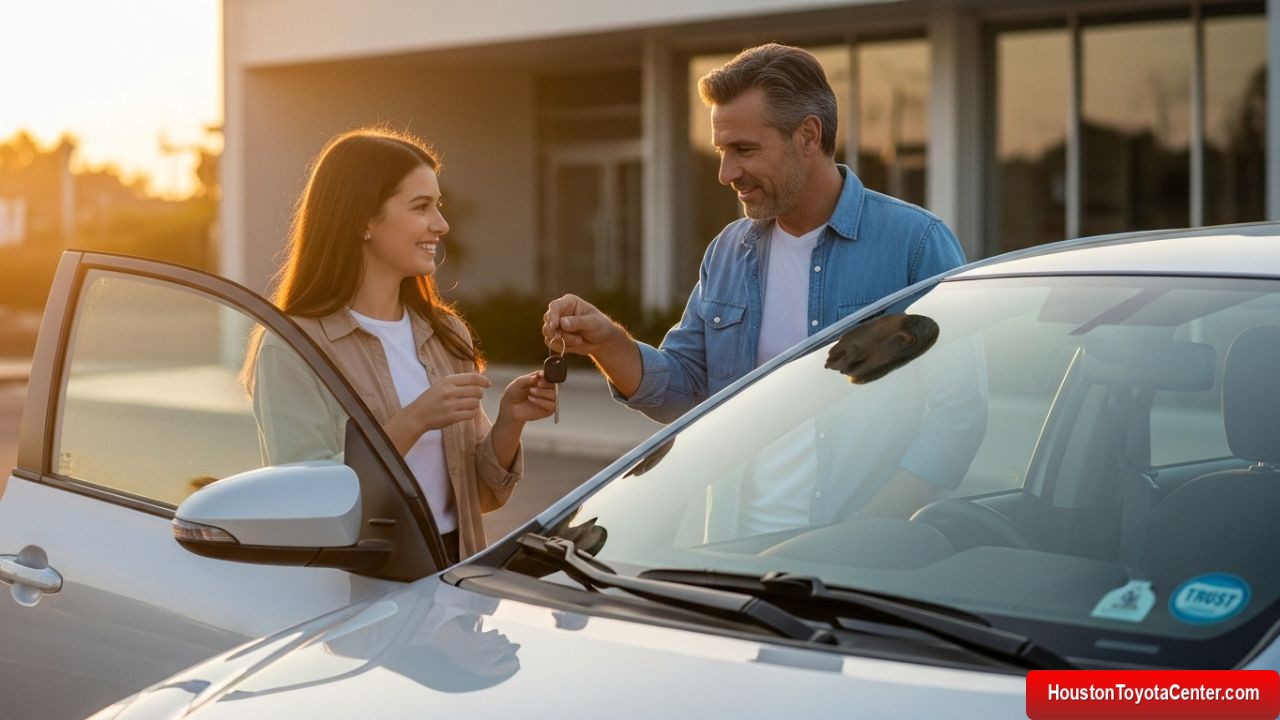When your teenager gets behind the wheel for the first time, it can be both a proud and nerve-wracking milestone. The transition from passenger to driver marks a significant step toward independence, but it also introduces new responsibilities and risks. Teen drivers are statistically more likely to be involved in car crashes than any other age group, making safety education and smart vehicle choices absolutely crucial.
This guide explores everything parents and guardians need to know — from setting clear driving rules and understanding the psychology of teen drivers, to selecting the safest first car that balances budget, performance, and peace of mind.
🚗 Understanding the Risks of Teen Driving
Driving requires coordination, focus, and judgment — skills that develop fully only with time and experience. Teenagers, however, often overestimate their driving abilities and underestimate potential dangers.
According to the National Highway Traffic Safety Administration (NHTSA), motor vehicle crashes remain the leading cause of death for teens aged 16–19 in the U.S. Several factors contribute to this high risk:
FREE: Quickly identify and understand problems with your vehicle 🚘
CLICK HERE- Inexperience: Teens have less practice recognizing hazards and reacting appropriately.
- Distraction: Smartphones, loud music, and peer passengers increase crash risk.
- Speeding: A sense of invincibility often leads young drivers to exceed speed limits.
- Night driving: Fatal crashes are more likely to occur at night, especially on weekends.
- Seat belt neglect: Many teens fail to buckle up, particularly when riding with friends.
To combat these risks, proactive parental involvement and responsible vehicle choices are key.
🧭 Setting Ground Rules for Teen Drivers
Rules aren’t about restriction — they’re about protection. Setting expectations early helps teenagers understand that driving is a privilege earned through trust and responsibility. Below are some of the most effective strategies to establish safe driving habits.
1. Create a Parent-Teen Driving Agreement
Put rules in writing. A formal agreement emphasizes that driving has conditions. Include details such as:
- Curfew hours (e.g., no driving after 10 PM)
- Passenger limits (no more than one peer passenger)
- Zero tolerance for drugs or alcohol
- Mandatory seat belt use
- No phone use while driving
Both parties can sign it, making it a mutual commitment to safety.
2. Model Responsible Driving
Teens learn more from observation than instruction. Always wear your seatbelt, avoid aggressive driving, and keep your phone out of reach. Your habits will influence theirs.
3. Limit Nighttime and Highway Driving Initially
For the first six months, encourage driving only in daylight and low-traffic areas. Gradual exposure helps build confidence before tackling complex road environments.
4. Supervise Practice Hours
Many states require a minimum number of supervised hours before a teen can drive solo. Go beyond the minimum — aim for at least 60 hours, including diverse conditions like rain, night, and heavy traffic.
5. Discuss Peer Pressure
Teens often feel pressure to impress friends. Role-play scenarios in which they must refuse to speed or allow distractions. Building assertiveness is as important as teaching driving mechanics.
🧠 The Psychology Behind Teen Driving Behavior
Understanding why teens make risky driving decisions can help parents guide them better.
During adolescence, the brain’s prefrontal cortex — responsible for judgment and impulse control — is still developing. Meanwhile, the limbic system, which drives emotion and thrill-seeking, is highly active. This imbalance explains why teens might chase excitement even when they know the risks.
Moreover, peer presence amplifies risky choices. A AAA Foundation study found that teen drivers with peer passengers are 44% more likely to crash. The solution? Limit passengers until driving maturity increases.
🛠️ Technology That Can Help Keep Teens Safe
Modern cars come equipped with smart safety technology that can help monitor and protect young drivers. These features can provide parents with peace of mind and teach teens accountability.
| Technology | Function | Why It Helps Teens |
|---|---|---|
| Automatic Emergency Braking (AEB) | Detects obstacles and brakes automatically | Reduces rear-end and collision severity |
| Lane Departure Warning (LDW) | Alerts driver when drifting out of lane | Prevents unintentional lane changes |
| Blind-Spot Monitoring (BSM) | Warns of vehicles in adjacent lanes | Enhances awareness during lane changes |
| Speed Limiter or Governor | Caps the top speed of the car | Prevents reckless speeding |
| Geofencing Apps (e.g., Toyota’s Safety Connect) | Sends alerts if car leaves a set area | Monitors driving zones |
| Driving Reports | Tracks speed, braking, and acceleration | Encourages self-correction and safe habits |
If your family already owns a modern Toyota, these features might be built-in. The Toyota Safety Sense™ (TSS) suite, for example, includes Pre-Collision Systems, Lane Tracing Assist, and Dynamic Radar Cruise Control — all valuable for inexperienced drivers.
🧾 Insurance and Financial Considerations
Insurance premiums for teen drivers can be shockingly high — sometimes doubling family policy costs. However, you can reduce expenses through strategic choices and discounts.
1. Choose the Right Car
Insurance companies reward vehicles with proven safety records and low repair costs. Compact sedans and midsize SUVs are often cheaper to insure than sports cars or luxury vehicles.
2. Maintain Good Grades
Many insurers offer “Good Student Discounts” for maintaining a B average or higher, reducing premiums by 10–20%.
3. Complete Defensive Driving Courses
Certifications from accredited schools not only build confidence but also qualify for additional discounts.
4. Add the Teen to a Family Policy
A shared policy is almost always cheaper than a separate one.
🧰 How to Choose the Safest First Car for a Teen
The car your teen drives matters as much as how they drive. Choosing the right vehicle involves balancing safety, reliability, affordability, and practicality.
Let’s break down the most important factors:
1. Safety Ratings
Always check ratings from organizations like:
- NHTSA (National Highway Traffic Safety Administration)
- IIHS (Insurance Institute for Highway Safety)
Aim for cars with 5-star NHTSA ratings or IIHS “Top Safety Pick+” designations.
2. Size and Weight
While smaller cars are more fuel-efficient, they offer less protection in crashes. A compact or midsize sedan is an ideal middle ground — easy to handle but sturdy enough to absorb impact.
3. Avoid Excessive Power
Skip turbocharged engines or sports trims. They encourage speeding and aggressive driving. Choose moderate horsepower for better control and fuel economy.
4. Reliability and Maintenance
Stick with brands known for durability and low maintenance costs — such as Toyota, Honda, or Subaru. Used cars can be an excellent value if they come with solid service records and modern safety systems.
5. Advanced Safety Features
Look for these essentials:
- Anti-lock Brakes (ABS)
- Electronic Stability Control (ESC)
- Multiple airbags
- Backup camera
- Tire Pressure Monitoring System (TPMS)
🧩 Top Safe Car Picks for Teen Drivers (2025 Edition)
Below is a table of vehicles often recommended for new drivers — prioritizing safety, reliability, and affordability.
| Vehicle | Type | Key Safety Features | Approx. Price (Used) | Why It’s Ideal for Teens |
|---|---|---|---|---|
| Toyota Corolla | Compact Sedan | TSS suite, lane departure alert, AEB | $15,000–$22,000 | Affordable, low maintenance, easy to handle |
| Honda Civic | Compact Sedan | Collision mitigation braking, lane keep assist | $16,000–$23,000 | Great safety record and reliability |
| Subaru Impreza | AWD Sedan | EyeSight Driver Assist Tech | $14,000–$21,000 | Excellent traction and visibility |
| Mazda3 | Compact Sedan | Adaptive cruise control, blind-spot monitoring | $15,000–$22,000 | Sporty but stable and predictable |
| Hyundai Elantra | Compact Sedan | Forward collision avoidance, smart cruise | $13,000–$20,000 | Economical and high safety scores |
| Toyota RAV4 | Small SUV | TSS 2.5, full-speed radar cruise | $20,000–$30,000 | Extra visibility and space |
| Honda CR-V | Small SUV | Road departure mitigation, adaptive cruise | $21,000–$29,000 | Family favorite for comfort and dependability |
All these models combine affordability, advanced safety tech, and proven reliability — three pillars of teen-friendly driving.
⚙️ New vs. Used: What’s Better for a Teen?
Many parents wrestle with whether to buy a new or used car for their teen. Let’s weigh the pros and cons:
| Option | Pros | Cons |
|---|---|---|
| New Car | Latest safety features, warranty, peace of mind | Expensive, higher insurance costs |
| Used Car | Lower price, lower insurance, depreciation already absorbed | May lack modern tech, potential repair costs |
Verdict: A certified pre-owned (CPO) car from a trusted dealer offers the best balance — safety, reliability, and value.
🛣️ Practical Tips for Parents and Teens
Here are actionable steps to reinforce safety long after your teen receives their license:
- Regularly review driving performance. Use feedback apps or ride along occasionally.
- Maintain the car. Check tire pressure, oil, and brakes monthly.
- Keep emergency supplies. A kit with jumper cables, flashlight, and first aid can be lifesaving.
- Discuss weather driving. Teach how to handle rain, fog, or icy conditions safely.
- Stay up to date with recalls. Always check the VIN on the NHTSA website.
- Encourage defensive driving. Always anticipate others’ mistakes on the road.
🧑🏫 Building Confidence Behind the Wheel
Confidence comes with practice and positive reinforcement. Celebrate milestones — the first month without violations, successful parallel parking, or consistent seat belt use. Small achievements help teens feel responsible rather than policed.
Encourage them to view driving as a lifelong skill, not a temporary phase. Remind them that safe driving habits today set the foundation for a lifetime of independence and safety.
🔍 How Toyota Leads in Teen Safety
If you’re searching for a car for your teen in Houston, Toyota’s lineup is a standout choice. Models like the Corolla, Camry, RAV4, and Prius come equipped with Toyota Safety Sense™, a bundle of advanced safety features designed to prevent accidents before they happen.
Toyota also offers the Safety Connect® service — providing emergency assistance, stolen vehicle locator, and automatic collision notification — perfect for peace of mind when your teen drives alone.
At Houston Toyota Center, families can explore a variety of CPO (Certified Pre-Owned) Toyotas that have passed rigorous inspections and include warranty coverage, blending affordability with maximum safety.
❤️ Final Thoughts: Safety Over Style
It’s natural for teens to want something cool — a car that feels like freedom. But as a parent or guardian, your focus should be on function, safety, and maturity. The best first car is one that helps them build good driving habits, not one that tempts them into risky behavior.
By combining clear rules, consistent guidance, and a safe, reliable vehicle, you’re setting your teen up for success — on the road and beyond.
✅ Key Takeaways
- Set firm rules and communicate openly about driving responsibilities.
- Choose a vehicle with top safety ratings and essential driver-assist features.
- Model safe behavior — your driving habits shape theirs.
- Encourage gradual independence through monitored practice.
- Consider Toyota’s Safety Sense™ models for top-rated protection and reliability.
Driving is a life-changing skill. With preparation, patience, and partnership, parents and teens can make this journey not just exciting — but safe, smart, and empowering.


Leave a Reply